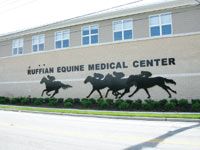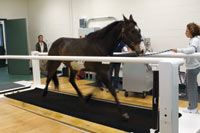New Ruffian Equine Medical Center serves Long Island, region
Elmont, N.Y. - Ruffian was considered by many to be the finest Thoroughbred filly in racing history. It is on the site of her burial that the Ruffian Equine Medical Center opened this year.
Elmont, N.Y. — Ruffian, considered by many to be the finest Thoroughbred filly in racing history, died July 7, 1975, after a severe injury and breakdown during her match race at Belmont Park.

Photo 1: Horses are able to walk across the street from the Belmont Park backstretch to the new REMC facility for treatment. Others come by ambulance, while horses of all classes are vanned in from throughout Long Island.
It was her 11th race. She had won all of her previous 10. This time, she injured her shoulder leaving the starting gate and, despite the pain, was still a half-length ahead of her male foe, Kentucky Derby winner Foolish Pleasure, when both sesamoid bones in her right foreleg shattered, comminuted, bone fragments bursting through the fetlock skin, contaminated by the racetrack sand. Ruffian underwent four hours of emergency surgery by a team of four veterinarians and a human orthopedic surgeon, headed by William O. Reed, DVM. During recovery, the filly re-injured herself as she thrashed about wildly in a padded stall, as if trying to run a race lying on her side.
She was euthanized and buried in the Belmont Park infield, head pointed toward the finish line.
It was on that very site that the Ruffian Equine Medical Center (REMC) opened June 1 of this year, more than 34 years after Ruffian's death, and after more than four years of planning and construction at a cost of nearly $18 million.
The facility is owned by IEAH (International Equine Acquisitions Holdings) Corp., and the veterinary practice is owned and operated by James C. Hunt, DVM, (who had trained under Ruffian's surgeon, Reed) and is overseen by Patricia Hogan, VMD, Dipl. ACVS, chief of surgery.

Photo 2: The high-speed treadmill simulates exercise at a maximum of 35 mph, with an incline to get the horse to its maximal exertion for various evaluations.
The staff also includes another surgeon, Chris Byron, DVM, Dipl. ACVS, formerly of the University of Illinois; a boarded anesthesiologist, Rachael Carpenter, DVM; an intern; eight veterinary assistants and two secretarial assistants.
The state-of-the-art, 22,000-square-foot facility serves not only horses from Belmont Park and nearby Aqueduct Racecourse, but also horses of all breeds and disciplines from throughout Long Island and parts of New England for diagnostics and treatment.
Before its opening, injured horses often needed to be vanned long distances to other equine facilities.
The new REMC has treated several horses per day, many walking across from the racetrack and others arriving by van or ambulance, and can handle multiple surgeries daily.

Photo 3: REMC's high-power digital radiography unit with overhead high-power generator provides quality X-rays that can then be called up on a computer screen for evaluation.
It has 29 stalls (11 x 11), 26 of which are outdoors in an enclosed barn, with an additional three climate-controlled stalls indoors. Each is quiet, well-lighted and ventilated. Hay and other feeds are delivered via an overhead conveyer belt.
The three indoor stalls serve a number of purposes. One is for bone scans, isolated because of isotope use. Others provide a climate-controlled environment to keep very ill horses out of extreme heat or cold outside. One of the indoor stalls has a sling hoist to provide support for horses with potential laminitis, a bad fracture or lameness issue. With the sling in place, the animals still can walk freely in the stall.
Indoor-stall base flooring is of special hard rubber for the comfort of recuperating horses, while barn stall floors are concrete for easier cleaning. All floors have non-skid surfaces.
A 150-foot-long, fenced-in paved strip just outside the stalls is used for jogging horses when evaluating for lameness.
The facility has a computed tomography (CT) unit in another large room that can double as an extra surgery room. The CT unit provides a complete 3-D reconstruction of a horse's leg in less than a minute.
The REMC also has a nuclear scintigraphy bone-scan unit. "We are getting wonderful images; it is very sensitive," says Hogan. A pit in the floor allows for helpful camera angles from below that would be impossible on level ground, she says.
Bone-scan analysis has been booked since the center opened. "We can't do any more; we're at our maximum," says Hogan. Two patients per day is the limit because of the two hours required for each and the need to perform the isotope injection in an isolated stall. "It's definitely needed for these kinds of horses. They're perfect candidates for stress fractures," Hogan says. "It's a wonderful tool for preventive purposes." On Long Island, the center has access to two generators that make the isotopes.
There is a main digital radiography unit with an overhead high-power generator and three portable units. Instead of being placed on a view box, X-rays are observed on a computer screen.
Surgery teleconferences
The surgical suite has a hydraulic table with a 60-inch video screen mounted on the ceiling above it. X-rays, CT scan results and other diagnostics may be viewed on the video monitor. Also above the surgical table is a video camera where anyone can teleconference with Hogan via computer.
"It's our goal to make this the best hospital possible," Hogan says. "If I'm doing a surgery and need help from someone who may have a better handle on things, that person can log onto their computer, get on this wavelength and look at what I'm doing. They can zoom in to the field, or zoom out to the whole picture. They can talk to me, give advice or make comments in real time."
Another area houses a high-speed treadmill that can exercise a horse at a maximum of 35 mph or higher, with an incline to produce the most exertion for evaluation. Several key functions can be monitored at once with the horse at maximum exertion. "Primarily you're evaluating upper-airway conditions," Hogan explains, "but sometimes it's for lameness, electrolyte imbalances, or heart imbalances."
The REMC is designed as a referral center, for diagnostics, certain emer-gency medical situations, and orthopedic and soft-tissue surgeries. "If a veterinarian sends a horse here for work, once discharged, we send it back to them for their continued care," Hunt says. It is not an ambulatory clinic.
"Long Island has never had a facility of this scale," he adds. "With a captive population of 2,500 to 3,000 horses right across the street at Belmont Park, this might lead to some interesting research projects that certainly might help us all in the long run. Maybe we'll start a research foundation, perhaps in Dr. Reed's name, to give grants to veterinarians that might want to come here. He was a pioneer. He ... came through the heavy vines to the clearing where we are now."
Reed's widow attended the ribbon-cutting ceremony for the REMC opening. "She was bowled over," Hunt says. "She said, 'Bill would have loved this place.'"
Kane is a Seattle author, researcher and consultant in animal nutrition, physiology and veterinary medicine, with a background in horses, pets and livestock.